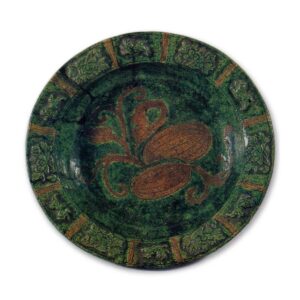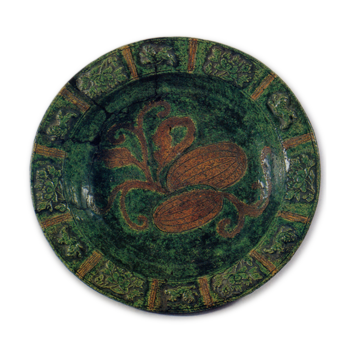
Height 6.0 cm, mouth diameter 33.0 cm, base diameter 19.4 cm
Tokyo National Museum
On the back of the lid of the inner box, Jyoshinsai wrote, “Bowl, lion and two peonies, by Chojiro, from Raku, left (kasho). Although this bowl came from the Raku family, it was moved to the Konoike family for some reason, and it is thought that Nyoshinsai wrote the inscription on it at that time. It is a flat bowl with a wrought mouth shape, and the finger marks on the base suggest that it was formed by hand, without using a steep rut. The entire bowl is thickly constructed, especially around the bottom, and is made of red clay that is slightly finer than that of tea bowls. Two gourd fruits, leaves, and vines are carved in lines on the surface, and the bell-shaped rim is divided into 12 sections, with a floating pattern of lions and peonies alternately pasted on the inside. The yuzu is yellowish-brown on the gourd, green yuzu on the ground, and the rim is also painted in yellow and green yuzu, clearly following the technique of kotsuji ware, and the yuzu tone is very similar to that of the “three-color lion incense burner” (fig. 91) inscribed “Toshi-60 Tanaka Tenkaichi Sokei (Hanashii) Bunroku 3-nen September Yoshinichi”. The lion peony top seems to have been made in the same style as the “brown glazed incense burner with lion peony decoration” (fig. 97), which has the Jokei mark and is owned by the Tokyo National Museum. If so, this flat bowl can be attributed to Sokei, Tsunekei, Chojiro, Sojiro, or others, and is a valuable source of evidence that this type of two-color, three-color, or other so-called koji-style ware was produced in early Juraku ware prior to Tsunekei.



